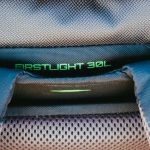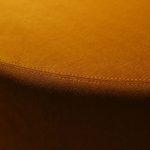Tetron fabric is usually a blend of about 65% polyester and 35% cotton, combining the best of both fibers. You get polyester’s strength, wrinkle resistance, and quick-drying benefits along with cotton’s softness and breathability. This makes Tetron durable, comfortable, and easy to care for, ideal for clothing and home textiles. If you want to understand how this fabric is made, its uses, and how to care for it properly, there’s plenty more to explore.
Table of Contents
Key Takeaways
- Tetron fabric is a polyester-cotton blend, commonly around 65% polyester and 35% cotton.
- Polyester adds strength, wrinkle resistance, and quick-drying properties to Tetron fabric.
- Cotton fibers in Tetron enhance breathability and softness for comfortable wear.
- Tetron combines durability with a soft feel, making it suitable for clothing and home textiles.
- Variations in blend ratios affect Tetron’s texture, care needs, and overall performance.
What Is Tetron Fabric Made Of?
Tetron fabric is a type of polyester blend that combines durability with comfort. When you wear or use Tetron, you’re experiencing a mix primarily made from polyester and cotton fibers.
This combination capitalizes on the strengths of both materials—polyester offers strength, wrinkle resistance, and quick drying, while cotton adds breathability and softness. Manufacturers often blend about 65% polyester with 35% cotton, though ratios can vary depending on the intended use.
You’ll find this fabric in clothing, upholstery, and home textiles because it’s easy to maintain and feels comfortable against the skin. By understanding its composition, you can appreciate why Tetron feels durable yet soft, making it a practical choice for everyday wear and household items.
The History Behind Tetron Textile
Although synthetic fibers had been around for some time, the development of Tetron textile marked a significant leap in fabric technology during the mid-20th century. You’ll find that Tetron was introduced by combining polyester and cotton, aiming to improve durability and comfort. This innovation quickly gained traction in the textile industry due to its practicality. As you explore its history, you’ll notice how Tetron filled the gap between natural and fully synthetic fabrics, offering the best of both worlds.
| Year | Event | Impact |
|---|---|---|
| 1950s | Introduction of Tetron fabric | Enhanced fabric durability |
| 1960s | Mass production begins | Wider accessibility |
| 1970s | Fashion adoption | Popularity in clothing |
| 1980s | Technological improvements | Improved texture and feel |
| 1990s | Global expansion | Worldwide textile industry use |
Key Properties of Tetron Fabric
When you choose a fabric for durability and comfort, you’ll find Tetron stands out due to its unique blend of polyester and cotton.
This combination gives Tetron fabric key properties that make it a reliable choice for everyday wear and home textiles. It resists wrinkles, making your clothes look crisp without much effort. Tetron also dries quickly, so you won’t have to wait long after washing. Additionally, its strength helps it withstand frequent use without losing shape or color.
Tetron fabric offers wrinkle resistance, quick drying, and lasting strength for everyday wear and home use.
Here are three key properties you’ll appreciate:
- Durability: Keeps your garments looking fresh, wear after wear
- Wrinkle resistance: Saves time on ironing and keeps you looking sharp
- Quick-drying: Makes laundry less of a hassle and fits your busy lifestyle
Advantages of Using Tetron in Clothing
Because it combines the best qualities of polyester and cotton, you’ll find Tetron clothing offers exceptional comfort and long-lasting wear.
You’ll appreciate its wrinkle resistance, which keeps your clothes looking fresh without constant ironing.
Tetron’s moisture-wicking ability helps you stay dry and comfortable throughout the day, making it ideal for active lifestyles.
You won’t have to worry about shrinkage or fading, as Tetron maintains its shape and color even after multiple washes.
Plus, its durability means your garments will withstand regular use, saving you money over time.
If you’re seeking fabric that balances softness with strength, Tetron provides just that, making it a smart choice for everyday wear, uniforms, and casual outfits alike.
How Tetron Fabric Is Manufactured
The qualities that make Tetron fabric so appealing stem from its unique manufacturing process. You start with polyester and cotton fibers, blending them to combine durability with softness.
The fibers undergo spinning, where they’re twisted into strong yarns that resist wear and tear. Then, weaving or knitting weaves these yarns into fabric, giving Tetron its smooth texture and resilience.
This careful process guarantees you get a fabric that feels comfortable yet stands up to everyday use.
When you choose Tetron, you’re embracing:
- A fabric crafted for lasting comfort
- Materials blended to balance strength and softness
- Quality production that supports reliable performance
This meticulous manufacturing gives Tetron its signature qualities you’ll appreciate in your clothing.
Differences Between Tetron and Other Polyester Blends
Although Tetron shares polyester as a base with many other fabric blends, it stands out due to its unique combination with cotton fibers, which enhances both comfort and durability.
When you compare Tetron to pure polyester blends, you’ll notice it feels softer and breathes better, thanks to the cotton content.
Unlike blends that mix polyester with rayon or nylon, Tetron maintains a balance between wrinkle resistance and moisture absorption, making it more comfortable for everyday wear.
Tetron strikes the perfect balance of wrinkle resistance and moisture absorption for comfortable everyday wear.
You’ll also find that Tetron is less prone to static cling and offers better color retention after washing.
If you want a fabric that combines the strength and easy care of polyester with the natural feel of cotton, Tetron is a smart choice over other polyester blends.
Common Uses of Tetron in Home Textiles
When you choose Tetron for your home textiles, you’re opting for a fabric that combines durability with comfort.
Tetron’s strength and wrinkle resistance make it a favorite for items that see daily use yet need to stay looking fresh. You’ll find Tetron commonly used in curtains, upholstery, and bedding, where its easy care and lasting color make a real difference.
Here are some common uses where Tetron truly shines:
- Curtains that maintain their shape and color, even in sunlight
- Upholstery that resists wear and tear yet feels soft
- Bedding that stays smooth and comfortable night after night
Tetron helps you create a cozy, stylish home without sacrificing practicality.
Care and Maintenance Tips for Tetron Fabric
Since Tetron fabrics are designed to withstand daily use while keeping their look, taking proper care helps you extend their lifespan even further.
You should wash Tetron items in cold or lukewarm water using a gentle cycle to prevent damage. Avoid bleach as it can weaken fibers and dull colors.
When drying, opt for air drying or use a low heat setting in the dryer to maintain fabric integrity. Iron on a low temperature if necessary, and always check the care label first.
To keep Tetron looking fresh, store it away from direct sunlight, which can cause fading. Spot clean stains promptly with mild detergent to avoid permanent marks.
Environmental Impact of Tetron Production
When you think about Tetron production, you’ll want to contemplate the energy it consumes and the chemicals involved.
You should also pay attention to how waste is managed during the process. These factors play a big role in the fabric’s overall environmental impact.
Energy Consumption Levels
Although producing Tetron fabric involves advanced technology, you should be aware that its energy consumption levels greatly affect the environment.
The manufacturing process demands significant electricity and heat, often sourced from fossil fuels, which contributes to carbon emissions. When you choose Tetron products, you indirectly support this energy-intensive cycle. Understanding this impact helps you make informed decisions about sustainability.
Consider how energy consumption in Tetron production can:
- Increase greenhouse gas emissions, accelerating climate change
- Strain natural resources, leading to environmental degradation
- Raise your carbon footprint, affecting future generations
Chemical Usage Effects
Because Tetron production relies heavily on various chemicals, you should understand how their use impacts the environment.
The manufacturing process often involves solvents, dyes, and finishing agents, which can release harmful substances into the air and water if not properly controlled. These chemicals contribute to pollution, affecting local ecosystems and potentially harming wildlife.
You’ll also find that some chemicals used are toxic or non-biodegradable, increasing environmental risks. Additionally, chemical runoff can contaminate water sources, posing health hazards to nearby communities.
While manufacturers are improving practices by adopting greener alternatives, the current chemical usage still demands careful monitoring.
Being aware of these effects helps you make informed choices about Tetron products and encourages support for more sustainable fabric production methods.
Waste Management Practices
Since Tetron production generates significant waste, managing it properly is crucial to minimizing environmental harm. You need to focus on reducing waste through recycling and safe disposal methods.
Many factories now implement waste segregation to guarantee hazardous chemicals don’t contaminate the environment. By adopting eco-friendly waste management, you help protect ecosystems from pollution caused by synthetic fiber residues.
When you consider how waste affects nature, remember:
- Toxic waste can poison soil and waterways, harming wildlife.
- Poor disposal practices increase greenhouse gas emissions, accelerating climate change.
- Neglected waste sites create unsightly pollution that impacts communities.
Taking responsibility for waste management isn’t just good practice—it’s essential for a sustainable future. You can make a difference by supporting brands that prioritize responsible Tetron waste handling.
Choosing the Right Tetron Fabric for Your Needs
You’ll want to contemplate fabric weight and texture to match your comfort and style preferences.
Think about durability and how much maintenance you’re willing to handle.
Finally, focus on the ideal uses and applications to make sure the Tetron fabric fits your specific needs.
Fabric Weight and Texture
Choosing the right Tetron fabric means understanding how fabric weight and texture affect its performance and feel.
You’ll find lighter Tetron fabrics offer breathability and softness, perfect for comfortable everyday wear. Heavier weights provide structure and a more formal appearance, ideal for uniforms or upholstery.
Texture also influences your experience—smooth finishes feel sleek against your skin, while slightly rougher weaves add durability and grip.
Consider these emotional benefits when selecting your Tetron fabric:
- Enjoy the cozy lightness that moves with you effortlessly.
- Feel confident in a fabric that holds its shape all day.
- Appreciate the subtle texture that adds character and uniqueness.
Durability and Maintenance
When selecting Tetron fabric, understanding its durability and maintenance needs can save you time and effort down the line. Tetron is known for its strength and resistance to wear, but different blends vary in how you care for them. You’ll benefit from knowing the right washing method and how well the fabric stands up to daily use.
| Aspect | Durability Level | Maintenance Tips |
|---|---|---|
| Pure Tetron | High resistance to tears | Machine wash cold, gentle |
| Tetron Blend | Moderate, less abrasion | Hand wash or delicate cycle |
| Coated Tetron | Very durable, water-resistant | Spot clean, avoid harsh chemicals |
Choosing wisely guarantees your fabric stays looking great longer with minimal upkeep.
Ideal Uses and Applications
Although Tetron fabric offers versatility, selecting the right type depends on your specific needs and environment.
If you want long-lasting clothing, choose Tetron blends that resist wrinkles and stains. For home décor, look for Tetron fabrics with a soft touch and vibrant color retention. When it comes to outdoor gear, prioritize Tetron varieties that provide breathability and quick drying.
Consider these ideal uses to guide your choice:
- Feel confident in professional attire that stays sharp all day
- Enjoy cozy, fade-resistant curtains that brighten your living space
- Trust durable, moisture-wicking materials for active wear and sports gear
Frequently Asked Questions
Can Tetron Fabric Be Recycled Effectively?
Imagine you drop off your Tetron clothes at a local recycling center. You’ll find that while Tetron fabric can be recycled, the process is complex, so not all facilities handle it effectively, limiting its recycling potential.
Is Tetron Fabric Hypoallergenic?
Tetron fabric generally isn’t hypoallergenic since it’s a polyester blend that may cause irritation for sensitive skin. If you have allergies, you’ll want to test it first or opt for natural fibers like cotton or bamboo instead.
How Does Tetron Fabric Behave in Extreme Temperatures?
You’ll find Tetron fabric handles moderate heat well but can melt under extreme temperatures since it’s synthetic. So, don’t expect it to perform like natural fibers in intense heat or freezing cold conditions.
Are There Any Known Health Risks From Tetron Fabric?
You won’t find significant health risks from tetron fabric; it’s generally safe and hypoallergenic. However, if you have sensitive skin, you might experience mild irritation, so it’s best to test it before prolonged use.
What Are the Common Dyes Used on Tetron Fabric?
Imagine dyeing Tetron fabric like a Victorian artist with vibrant colors; you’ll typically find reactive, disperse, and acid dyes used. These dyes bond well with Tetron’s polyester blend, ensuring bright, lasting hues you’ll love.
- Does Chiffon Fabric Stink - July 15, 2025
- Does Chiffon Fabric Affect the Economy - July 15, 2025
- Does Cotton Fabric Have a Nap - July 15, 2025







